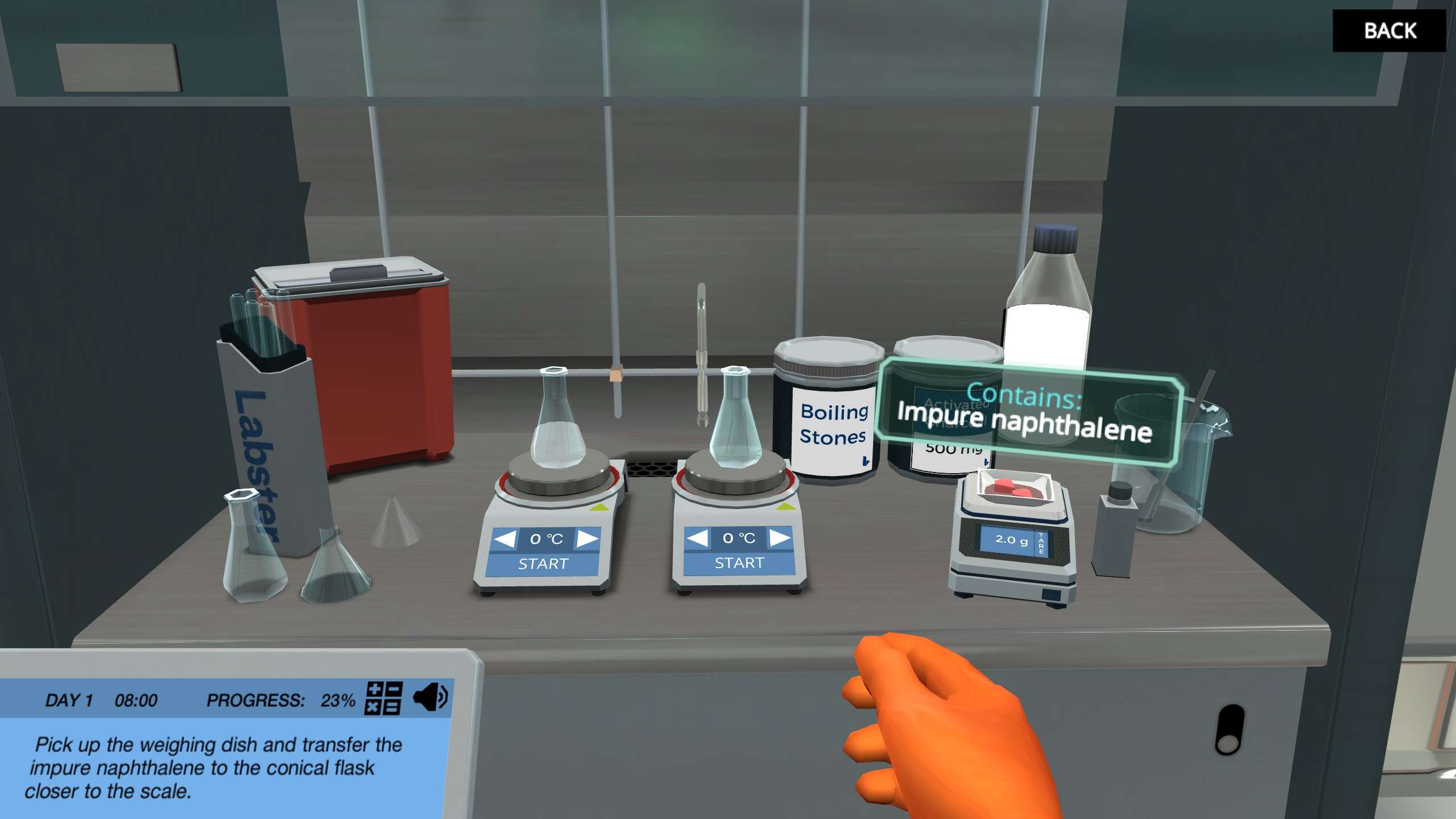Heading 1
Heading 2
Heading 3
Heading 4
Heading 5
Heading 6
Lorem ipsum dolor sit amet, consectetur adipiscing elit, sed do eiusmod tempor incididunt ut labore et dolore magna aliqua. Ut enim ad minim veniam, quis nostrud exercitation ullamco laboris nisi ut aliquip ex ea commodo consequat. Duis aute irure dolor in reprehenderit in voluptate velit esse cillum dolore eu fugiat nulla pariatur.
Block quote
Ordered list
- Item 1
- Item 2
- Item 3
Unordered list
- Item A
- Item B
- Item C
Bold text
Emphasis
Superscript
Subscript
About This Simulation
Have you ever wondered how to remove impurities from a solid? How can you be sure you’ve removed them if you do? Step into our recrystallization lab to learn how to purify a solid and check for its purity level!
Learning Objectives
- Explain the fundamentals of recrystallization theory and be able to describe the process on molecular and operational levels
- Carry out the recrystallization technique by following best practices
- Be able to troubleshoot and rectify common problems encountered in recrystallization
- Successfully recover a reaction product by performing suction filtration and drying the crystalline solid product
- Determine the melting point of a pure solid compound and by comparison explain the difference from crude sample data
About This Simulation
Lab Techniques
- Suction Filtration
- Melting points
- Recrystallization
Related Standards
- Alignment pending
- Alignment pending
- Alignment pending
Learn More About This Simulation
This is the full-length version of the “Recrystallization” simulation. You can also play the simulation in two smaller parts: "Recrystallization: Filter your crystals and measure the melting point" and "Recrystallization: Dissolve your solid and precipitate your crystals."
How can we purify a solid?
In this simulation, you will learn step by step how to purify a solid by using the recrystallization technique, and on top of that you will be able to filtrate your solid and check for its melting point range.
Recrystallize, filter, and check purity!
At the end of the simulation you will master three different techniques (yes you heard that right; three!): recrystallization, suction filtration, and melting point range.
Accelerated learning
Master the three techniques in a fraction of the time that it would take you in a real lab. Thanks to our ability to fast-forward time in our virtual labs, you’ll be able to skip all those waiting times in the process.
Understand the entire process and complete it step-by-step
You will apply three different techniques, but don’t worry, you will be presented with a whole overview of the process together with detailed instructions on how to complete the protocol. You’ll never be alone!
RELATED SIMULATIONS
Recrystallization: Filter your crystals and measure the melting point
Recrystallization: Dissolve your solid and precipitate your crystals
For Science Programs Providing a Learning Advantage
Boost STEM Pass Rates
Boost Learning with Fun
75% of students show high engagement and improved grades with Labster
Discover Simulations That Match Your Syllabus
Easily bolster your learning objectives with relevant, interactive content
Place Students in the Shoes of Real Scientists
Practice a lab procedure or visualize theory through narrative-driven scenarios


FAQs
Find answers to frequently asked questions.
Heading 1
Heading 2
Heading 3
Heading 4
Heading 5
Heading 6
Lorem ipsum dolor sit amet, consectetur adipiscing elit, sed do eiusmod tempor incididunt ut labore et dolore magna aliqua. Ut enim ad minim veniam, quis nostrud exercitation ullamco laboris nisi ut aliquip ex ea commodo consequat. Duis aute irure dolor in reprehenderit in voluptate velit esse cillum dolore eu fugiat nulla pariatur.
Block quote
Ordered list
- Item 1
- Item 2
- Item 3
Unordered list
- Item A
- Item B
- Item C
Bold text
Emphasis
Superscript
Subscript
A Labster virtual lab is an interactive, multimedia assignment that students access right from their computers. Many Labster virtual labs prepare students for success in college by introducing foundational knowledge using multimedia visualizations that make it easier to understand complex concepts. Other Labster virtual labs prepare learners for careers in STEM labs by giving them realistic practice on lab techniques and procedures.
Labster’s virtual lab simulations are created by scientists and designed to maximize engagement and interactivity. Unlike watching a video or reading a textbook, Labster virtual labs are interactive. To make progress, students must think critically and solve a real-world problem. We believe that learning by doing makes STEM stick.
Yes, Labster is compatible with all major LMS (Learning Management Systems) including Blackboard, Canvas, D2L, Moodle, and many others. Students can access Labster like any other assignment. If your institution does not choose an LMS integration, students will log into Labster’s Course Manager once they have an account created. Your institution will decide which is the best access method.
Labster is available for purchase by instructors, faculty, and administrators at education institutions. Purchasing our starter package, Labster Explorer, can be done using a credit card if you are located in the USA, Canada, or Mexico. If you are outside of North America or are choosing a higher plan, please speak with a Labster sales representative. Compare plans.
Labster supports a wide range of STEM courses at the high school, college, and university level across fields in biology, chemistry, physics, and health sciences. You can identify topics for your courses by searching our Content Catalog.















